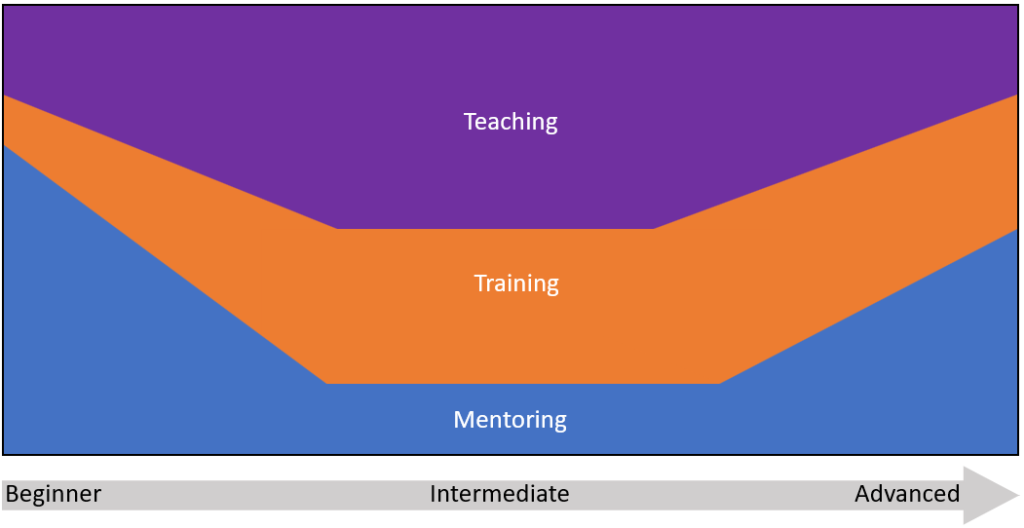To get strong, you start with light weights slowly increase to heavier weight. To become a better runner, you progressively increase the speed or distance. To learn a musical instrument, you start with simple scales and songs and progress to more challenging pieces and concepts. In all cases, we learn by progressively increasing difficulty such that the task stays challenging but not too challenging. We build a staircase where each new step is a little bit higher than the next. The same principle applies to learning Tango.
Beginner dancers often feel overwhelmed and lost, and most dancers struggle to integrate moves they learn in class into their dance in the milonga—both symptoms of the difficulty being set too high. At the same time, dancers who have been at it for a few years tend to plateau, reaching what psychology professor Anders Ericsson calls “that level of ‘acceptable’ performance and automaticity [where] the additional years of ‘practice’ don’t lead to improvement.”[1] This stagnation is a symptom of the difficulty being set too low.
The gym has nicely labeled weights that we can add, and we can change variables such as reps, sets, exercises, and recovery time to increase difficulty as we get stronger. But how do we vary the challenge of Tango? What are the variables that we can use to dial up or down the difficulty of the dance?
There are six variables that determine the difficulty of a move, sequence, concept, or really any part of the dance. I’ll call them familiarity, complexity, accuracy, timing, partnering, and navigating. A new movement is more difficult than a familiar movement. A complex pattern is more difficult than a simple pattern. Execution with precision and accuracy is more difficult than ‘just doing the step’. Specific timing and musicality is more difficult than doing a step to the beat or without music. Leading or following a step with a new partner is more difficult than with your regular partner. And finally, navigating a crowded milonga is more difficult than when no one else is around.
Familiarity, complexity, and accuracy are internal variables while timing, partnering, and navigating are external variables.[2] Internal variables are based on our own knowledge and actions—our familiarity with a concept, our choice of movement complexity, and our accuracy as a dancer. External variables depend on the external environment—who asks us to dance, what music is playing, and the amount of space.
Learning depends on being able to progressively vary the difficulty, so learning Tango depends on our ability to vary the difficulty of these six variables. Few if any dancers can accurately execute a new, complex move musically with a new partner in a crowded milonga. Something must give. The challenge is that in the milonga the external variables are not set by us.[3] The milonga dials up the external variables, increasing total difficulty, which often leads to sacrificing the development of internal variables to meet these difficulties. We all know dancers who pull out every complicated move, but without accuracy or grace. We also know dancers who may be musical and have a yummy embrace but just repeat the same few simple steps over and over at every marathon they attend. So many late-night Tango conversations revolve around the merits of fancy moves versus elegant posture versus connections versus musicality. But the truth is we can have it all. We can learn new concepts and dance complicated sequences musically and with connection in a crowded space. We just need to turn down the external dials for a bit.
For many of us, we go straight from learning a new step in a class to trying it out at the milonga. It ends up not working so we go back to our tried and true dance. But of course it doesn’t work. at the milonga all the difficulty dials are all turned up to 11. It’s a recipe for disaster. Instead of trying our new step at the milonga, first go to a quiet space. No music, no navigation, no need to perform, no distractions. Turn all the dials way down and then build back up. Start with getting familiar with the concept. Then break the movement into small components to reduce complexity. Drill each component and film ourselves to work on accuracy. Then start combining and adding back in the external variables. Play with different variations to work the lead and follow. Practice to different music to work on musicality. Start controlling the spacing, see how big and how small you can make the same movement. Ask for help and feedback along the way. Finally, test it out at a milonga. Soon enough you will have a new move to play with, dance and enjoy. By controlling your dials instead of being controlled by them, you build your staircase to become a more expressive and enjoyable dancer.
[1] Anders Ericsson spent much of his career studying what makes experts experts. I highly recommend checking out his research and writings. Quote comes from the book Peak: Secrets from the new Science of Expertise
[2] With a little word smithing, I was able to get the internal variables to end with ‘y’ and the external variables to end with ‘ing’, which can be helpful for identifying each.
[3] Granted, we can choose who we dance with and the songs we dance to. But the fact remains that it is generally frowned upon in the milonga to do things like trying the same move several times in a row paying no attention to the music or space.
